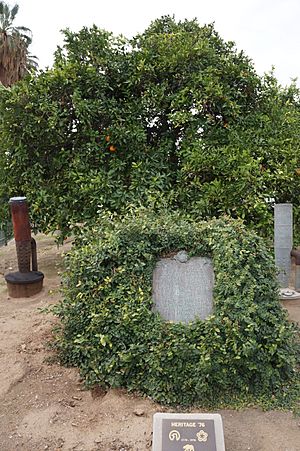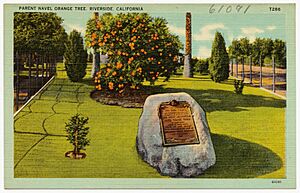Washington navel orange tree (Riverside, California) facts for kids
Quick facts for kids Parent Washington Navel Orange Tree |
|
|---|---|

Parent Washington Navel Orange Tree
|
|
| Location | Corner of Magnolia and Arlington Avenues, Riverside, California |
| Built | 1873 |
| Designated | June 1, 1932 |
| Reference no. | 20 |
| Lua error in Module:Location_map at line 420: attempt to index field 'wikibase' (a nil value). | |
The Parent Washington Navel Orange Tree is a very special tree in Riverside, California. It was planted by Eliza Tibbets way back in 1873. This tree is famous because it helped start California's huge orange industry. It's even recognized as a California Historic Landmark! This amazing tree is located at the corner of Magnolia and Arlington Avenues in Riverside.
Contents
How the Orange Came to California
The Washington Navel Orange has an interesting history. It started as a special kind of sweet orange found in a monastery in Brazil around 1820. This orange was unique because it had no seeds!
In 1870, the U.S. Department of Agriculture brought twelve of these special orange trees to the United States. They took small pieces, called buds, from these trees. These buds were then attached, or grafted, onto other California sweet orange trees.
Eliza Tibbets and the First Trees
In 1873, two of these young, greenhouse-grown trees were sent to Mrs. Eliza Tibbets in Riverside. She planted them, and one of them became the famous Parent Washington Navel Orange Tree. This tree helped make the Washington Navel Orange very popular across the country.
The name "navel orange" comes from a small bump at the bottom of the fruit. It looks a bit like a human belly button! This special feature is actually a natural change, or mutation, that also makes the orange seedless.
Oranges cannot survive in very cold weather. Luckily, the warm climate of Southern California was perfect for growing these new navel oranges. This helped the California citrus industry grow very quickly.
Protecting a Historic Tree
Keeping the Tree Healthy
This historic tree needs special care to stay healthy. In April 2018, a white cloth was placed over the tree. This was to protect it from a serious plant sickness called citrus greening disease.
Later, in June 2019, the cloth was replaced with a large tent. This tent is 22 feet tall and 25 feet wide. It has a special insect screen to keep harmful bugs away from the tree.
Who Takes Care of the Tree?
Taking care of the Parent Washington Navel Orange Tree is a team effort. The UC Riverside and the City of Riverside Parks Department work together to maintain it.
In April 2019, some other orange and grapefruit trees from the 1940s were removed. They were not as historically important as the Parent Washington Navel Orange Tree.
Historical Marker
Honoring Eliza Tibbets
There is a special historical marker at the site of the tree. It was put there in 1920. This marker honors Mrs. Eliza Tibbets for her important work. It praises her for planting the first Washington Navel Orange trees in California.
The marker also explains that this orange, originally from Bahia, Brazil, was a very valuable fruit. It was one of the best new fruits brought to the United States by the Department of Agriculture.
Details from the Guidebook
The California Historical Landmarks Guidebook also talks about this marker. It confirms that the tree came from Brazil in 1870. It also mentions that twelve young trees were received. Buds from these trees were then grown on other sweet orange seedlings. In 1873, two of these special trees were sent to Mrs. Eliza Tibbets in Riverside.
See also
- California Citrus State Historic Park
- California Historical Landmarks in Riverside County, California
- Mother Orange Tree
- Orcutt Ranch Horticulture Center
References


